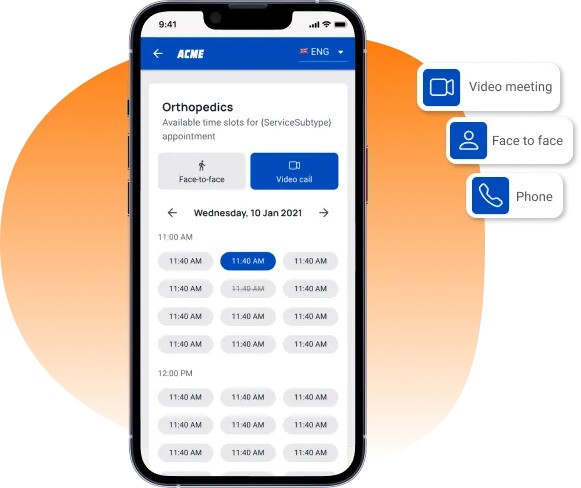Long waits, frustrated patients, and overburdened staff—these scenarios plague clinics without efficient scheduling systems. Running a clinic demands more than just good healthcare; managing patient flow and ensuring seamless operations matter just as much.
When clinics depend on outdated practices, bottlenecks happen, patients wait excessively, and their overall experience ends up suffering greatly. The solution? Appointment scheduling systems that not only reduce patient wait times but transform the entire process from check-in to check-out.
Industries that depend on efficient appointment systems—whether healthcare, government services, or beyond—require more than a simple booking calendar.
Today's scheduling software offers dynamic solutions that boost efficiency, optimize resources, and improve the patient experience. Let's explore how this technology reshapes patient flow and removes many operational headaches.
The Role of Appointment Scheduling Software in Patient Flow Management
Smooth patient flow doesn't just happen—it requires constant adjustment and real-time management. Clinics must handle multiple variables: clinician availability, patient arrival times, and resource allocation. Appointment scheduling software steps in to automate this process and balance these factors with precision.
Forget manual logs and hasty scheduling guesses. Systems like the Q-nomy appointment management system take the lead by offering real-time updates on patient loads, availability, and appointment patterns.
These tools analyze clinic traffic to anticipate surges and adjust scheduling accordingly. With this insight, clinics avoid overbooking, underutilization, or the dreaded waiting room pile-up.

Key Features of Appointment Scheduling Software
Appointment scheduling software offers more than just a calendar function. Clinics rely on these advanced systems for several key features that drive both efficiency and patient satisfaction.
- Real-time updates: As patients book, cancel, or reschedule, the system automatically reflects these changes across all platforms.
- Patient self-booking: Thanks to online portals and mobile apps, patients can skip phone calls and book their appointments with just a few taps. They choose times that work best for them, avoiding long phone holds or miscommunications.
- Automated reminders: Patients receive automated texts or emails reminding them of their upcoming visits, significantly lowering no-show rates.
Benefits of Appointment Scheduling Software for Patient Flow
Want to reduce patient wait times? Appointment scheduling software works wonders! It helps clinics stagger appointments so patients aren't stuck in overcrowded waiting rooms and can enjoy their visits.
Not only that, providers benefit as well. Clear schedules allow them to focus on patient care instead of constantly juggling logistics, giving them more time for meaningful, unrushed interactions.
On top of that, patients appreciate the convenience. Whether booking online, adjusting through an app, or getting reminders, they feel more in control, leading to fewer delays and a smoother experience overall.
Even better, the software gives clinics valuable insights. Managers can use this data to optimize staffing and resources.
How Appointment Scheduling Software Manages Peak Times
Every clinic hits those busy peak times when patient demand soars, and that can stress everyone out. Luckily, appointment scheduling software tackles this challenge by predicting and managing patient traffic during those hectic hours.
By analyzing past data and patient trends, the software staggers appointments to avoid overcrowding. For example, it can shift routine visits to quieter times, keeping peak hours open for urgent cases. This way, waiting rooms stay manageable, and high-priority patients receive prompt care.
Plus, advanced systems offer triage and prioritization features that let clinics adjust in real time. When sudden influxes occur, clinics can easily handle them without creating long waits. This flexibility helps maintain excellent service, even during the busiest hours.
Best Practices for Clinics Implementing Appointment Scheduling Software
For clinics ready to adopt this latest technology, success depends on proper implementation. Following these best practices ensures that your patient scheduling system works effectively from day one:
- Train all staff: Equip everyone, from front desk personnel to clinicians, with the skills to fully use the software. Hands-on training reduces errors and increases adoption.
- Customize the System: Every clinic has its own vibe, with different sizes and patient needs. A one-size-fits-all approach doesn't work, so tailor the system to fit your specific requirements for better performance.
- Educate Patients: Show patients how to use self-booking and online portals. Empowering them with easy-to-use tools lightens your admin load.
- Monitor Performance: Regularly review appointment trends to spot bottlenecks and improvement opportunities.
- Stay Adaptable: Patient needs change, so keep your system flexible and adjust settings as needed to stay ahead.
In Conclusion
When searching for healthcare scheduling software, remember it's not just about appointments. It's about enhancing patient satisfaction and ensuring patients feel that their providers are truly dedicated to their care.
Tools like the Q-nomy help clinics tackle busy hours and streamline operations. These systems provide useful insights that turn scheduling into a smart advantage.
For clinics looking to thrive in a competitive healthcare landscape, investing in healthcare scheduling software is key. Have you discovered a scheduling solution that truly made a difference? Share your thoughts in the comments below.





